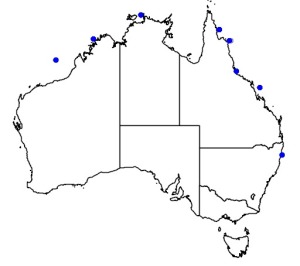�
�
�
���
Psammocora haimiana
Kingdom
Animalia
Phylum
Cnidaria
Class
Hexacorallia
Order
Scleractinia
Family
Siderastreidae
Genus
Psammocora
Species
Psammocora haimiana
Status
least concern
Colours
Distinguishing features
Blunt-ended columns that may have a foliose base. Distinctive corallite pattern. Polyps often extended during the day giving the colony a furry appearance.
Description of colony by Benzoni et al (2010): "Colony growth form can be variable but most commonly it is digitiform. Digitations columnar to claviform [=club-shaped] up to 30 cm in height. Base of colonies can be encrusting or have free margins and become foliose. Digitations do not anastamose [link with each other] but, if claviform, can grow very close at top. Digitations circular to oval in section with rounded ends."
Size
- Size data has not been obtained.
Synonyms
Similar taxa
-
Animalia:
species: Psammocora digitata
has tapering columns that are always oval in cross section, and can also be encrusting. The name P. digitata has been used extensively and erroneously for P. haimiana (Benzoni et al, 2010).
Distribution
Web resources
References
References that assist with identification
- Benzoni, F. Stefani, M. Pichon and P. Galli, F. (2010). The name game: morpho-molecular species boundaries in the genus Psammocora (Cnidaria, Scleractinia). Zoological Journal of the Linnean Society, 160: 421–456, . LIRS catalog number 90311.
Other references
- Dinesen, Z.D. (1983). Shade-dwelling corals of the Great Barrier Reef, Marine Ecology Progress Series, 10: 173-185. LIRS catalog number 157.
- Dornelas, M. (2006). Coral assemblages and neutral theory. PhD thesis, James Cook University. LIRS catalog number 1626.
- View all references






